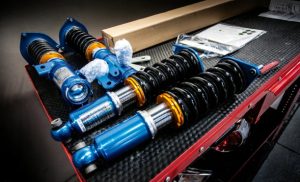In motorsport, every fraction of a second counts. While most enthusiasts focus on power upgrades or tire compounds, one of the most decisive factors for lap times and vehicle control is often overlooked — the shock absorber. In performance driving, the right set of shocks can transform how a car corners, brakes, and accelerates, giving the driver not just speed but consistency and confidence.
Choosing the right shock absorbers for track or motorsport use is not just about “stiffer is better.” It’s about balancing damping characteristics, suspension geometry, and vehicle dynamics to match specific racing conditions. Below, we’ll explore how to make an informed choice — from types and tuning options to setup considerations.
Why Shock Absorbers Matter on the Track

On a racetrack, shocks do far more than provide comfort — they define the car’s stability and grip envelope. Their main functions include:
-
Controlling weight transfer during acceleration, braking, and cornering
-
Maintaining consistent tyre contact with the asphalt
-
Preventing bottoming out on curbs or dips
-
Allowing precise steering feedback and balance adjustment
In motorsport, the suspension must react rapidly and predictably to high G-forces. The right damping rates enable smoother transitions between weight shifts, improving lap consistency and reducing tyre wear.
Types of Performance Shock Absorbers
| Type | Description | Best For | Pros / Cons |
|---|---|---|---|
| Twin-Tube Gas Shocks | Use an inner and outer tube; pressurized gas prevents cavitation. | Club-level racing, road-legal track cars | + Comfortable, affordable − Can fade under heavy load |
| Monotube Shocks | Single chamber with gas and oil separated by a floating piston. | Track days, time attack, rally | + Superior cooling and damping precision − Harsher ride on street |
| Adjustable Coilovers | Combine spring and damper with adjustable ride height and damping. | Professional motorsport and tuning | + Fully tunable − Expensive, requires expertise |
| Remote Reservoir Shocks | External oil reservoir increases fluid volume and cooling. | Endurance and off-road racing | + Excellent heat management − Complex installation |
Tip: For serious track use, monotube or adjustable coilovers are preferred due to their heat resistance and adjustability.
Key Parameters When Selecting Performance Shocks
When comparing models, consider the following specifications and their impact on handling:
| Parameter | Effect on Performance | Recommendation for Track Use |
|---|---|---|
| Compression Damping | Controls how fast the shock compresses under load. | Medium to high for firm response and stability. |
| Rebound Damping | Controls how quickly the shock extends after compression. | Slightly higher than compression to maintain tyre contact. |
| Spring Rate Compatibility | Determines ride stiffness. | Match to vehicle weight and cornering load. |
| Adjustability | Allows fine-tuning for track conditions. | At least 2-way (compression/rebound) adjustment preferred. |
| Body Material | Affects weight and heat dissipation. | Aluminium or steel with anodized finish for durability. |
How to Match Shocks to Your Motorsport Discipline
Not all racing conditions are alike — different events demand different damping strategies.
1. Circuit / Track Racing
-
Prioritize high-speed stability and responsive turn-in.
-
Go for monotube adjustable shocks with medium-high damping.
-
Pair with stiffer springs and anti-roll bars.
2. Autocross / Gymkhana
-
Requires quick suspension response and precise weight transfer.
-
Choose lightweight twin-tube gas shocks or entry-level coilovers.
-
Fine-tune rebound for rapid directional changes.
3. Rally / Off-Road Racing
-
Focus on long-travel damping and impact absorption.
-
Opt for remote reservoir or heavy-duty monotube shocks.
-
High oil capacity prevents overheating over rough terrain.
4. Drift / Time Attack
-
Needs a balance between grip and slide control.
-
Go for multi-way adjustable coilovers with independent rebound/compression settings.
-
Stiffer rear setup aids rotation; softer front improves front-end grip.
Common Mistakes When Choosing Performance Shocks
Even experienced racers make setup errors. Here are pitfalls to avoid:
-
Ignoring spring-shock matching — mismatched rates cause instability.
-
Choosing “race-only” stiffness for street use — reduces comfort and traction.
-
Skipping heat management — shocks that overheat lose damping power mid-race.
-
Neglecting corner-weight balancing after installation.
-
Buying based on brand hype instead of verified track data.
Pro tip: Always get your shocks installed and tuned by a motorsport suspension specialist who can corner-balance and align the car properly.
Understanding Adjustable Damping
Adjustability is what separates performance shocks from stock ones. Here’s how it works:
| Adjustment Type | Purpose | Effect on Handling |
|---|---|---|
| Single Adjustable | Controls rebound only | Simple tuning for handling balance |
| Double Adjustable | Controls both compression and rebound | Greater flexibility for track setup |
| Triple Adjustable | Adds high-speed vs low-speed compression | Ultimate fine-tuning for professional use |
High-speed damping affects bumps and kerbs, while low-speed damping influences body roll and weight transfer — the two most critical factors in cornering dynamics.
Setup and Maintenance for Track Performance
Even the best shocks need proper setup and care. Follow these steps for consistent performance:
Before the event:
-
Set ride height evenly and measure corner weights.
-
Check damper clicks (start from manufacturer’s baseline).
-
Verify tyre pressures and camber settings.
During track sessions:
-
Adjust rebound or compression after each session based on feel and telemetry.
-
Watch for uneven tyre wear — a sign of imbalance.
After each race:
-
Inspect for leaks, dust boot tears, and mount wear.
-
Replace shock oil every season for coilovers used in competition.
Example Setup Comparison
| Setup Type | Ride Comfort | Cornering Stability | Lap Consistency | Maintenance Level |
|---|---|---|---|---|
| Stock shocks | High | Low | Inconsistent | Low |
| Sport twin-tube | Medium | Moderate | Average | Low |
| Monotube performance | Medium-low | High | Good | Moderate |
| Adjustable coilovers | Low | Very high | Excellent | High |
As the table shows, track-oriented suspension sacrifices comfort for predictability and control. The key is selecting a system that matches your skill level, budget, and driving style.
Where to Buy Quality Performance Shocks

When shopping for performance shocks, focus on trusted brands that offer motorsport-grade engineering and compatibility with your specific vehicle. Avoid generic “race-look” kits that lack proper valving or certification.
For a wide range of reliable, track-proven shock absorbers, visit:
Buy Shock Absorbers online
You’ll find OEM-quality and high-performance options suited for everything from spirited street driving to professional track use.
Final Thoughts
Choosing the right performance shock absorbers for motorsport use isn’t about the stiffest or most expensive option — it’s about the right damping characteristics for your car, track, and goals.
A well-tuned suspension system allows your tyres to perform at their maximum grip potential, gives consistent driver feedback, and ultimately shortens lap times. Whether you’re a weekend racer or a serious competitor, investing in quality shocks and proper setup can be the difference between holding the line and losing control.
Take the time to select, install, and fine-tune your shocks properly — your lap times, tyres, and confidence will thank you.